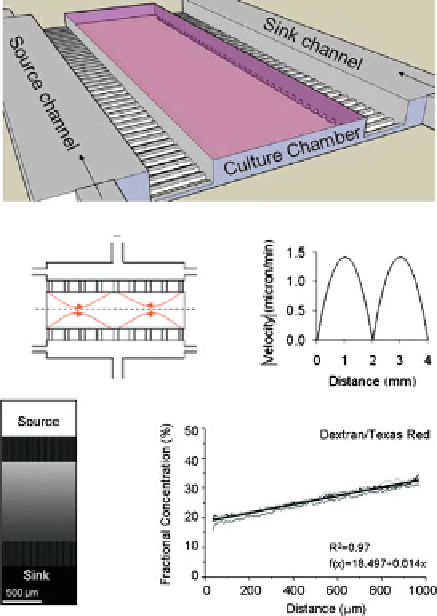Biomedical Engineering Reference
In-Depth Information
Fig. 4 Design and
characterization of a
''restricted-flow''
microfluidic device. a
Schematic of the device.
Finite element simulation, at
a flow rate of 8 nL/min, of
b fluid flow streamlines, with
flows at inlets and outlets
marked by black arrows, and
c absolute value of fluid
velocity along the dashed line
shown in b. d Validation of
the generated gradient using
FITC-labeled dextran
(Mw = 20 kDa, similar to
VEGF-165), originally
published in [
30
].
Reproduced by permission of
The Royal Society of
Chemistry,
http://dx.doi.org/
10.1039/C005069E
. e The
concentration profile of Texas
red-labeled dextran across the
culture chamber. Originally
published in [
70
]
a
300 µm
b
c
d
e
physiological environment of the cultured cells. This microfluidic device enables
application of quantitatively specified linear gradients to study (1) sprouting over a
period of days, (2) the contribution of matrix properties, and (3) interactions
between concentration magnitude, gradient steepness, and other inputs.
3 Background: Soluble Gradients in Angiogenesis
Soluble gradients impart directional signals that are critical to the formation of
functional blood vessels during wound healing and development. Soluble gradients
enable specialization of tip cells, pathfinding of sprouts to hypoxic tissue, and
vessel maturation via sprout inosculation and recruitment of pericytes. To elabo-
rate on the importance of gradient-mediated anisotropy to sprouting angiogenesis,
we briefly summarize the current knowledge about how gradients of VEGF and
other soluble factors regulate sprouting angiogenesis.
Soluble gradients arise and impart directionality during angiogenesis through
various biochemical and biophysical mechanisms. Upon hypoxic stress, cells
down-regulate the degradation of hypoxia inducible factors (HIFs), transcription















Search WWH ::

Custom Search